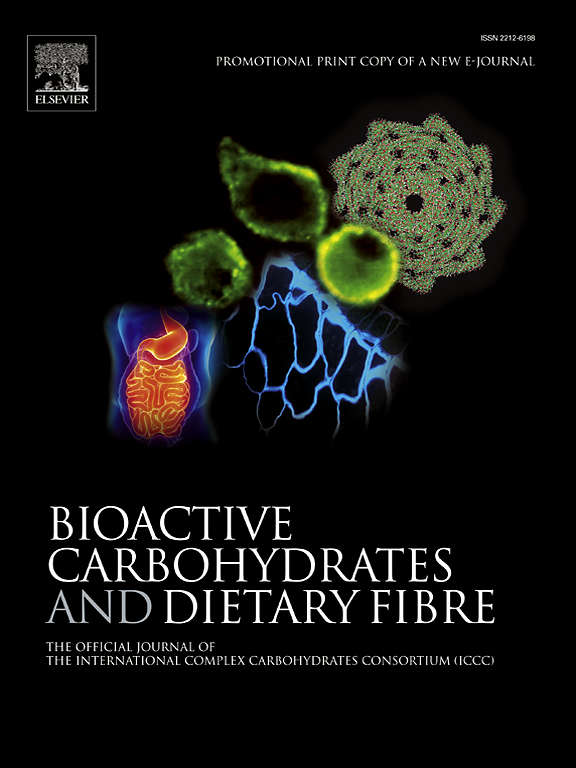Potential of curdlan use on the improving textural, cooking and sensory quality, and predicted glycemic index of high-fiber pasta added with watermelon rind
IF 3.6
引用次数: 0
Abstract
Addition of watermelon rind powder into pasta formulation enhances dietary fiber and antioxidant contents of the fortified pasta but reduces its textural, cooking and sensory quality. In the literature, curdlan has been extensively studied to improve the quality of noodles but its use in the making of durum wheat semolina pasta and high-fiber pasta has not been considered. This study sought to examine the impacts of curdlan addition on the rheological characteristics of dough as well as on the textural and cooking quality, predicted glycemic index, in-vitro protein digestibility and sensory acceptance of high-fiber pasta. In this investigation, different dosages of curdlan were used in the making of high-fiber pasta fortified with watermelon rind and the resulting pasta quality was assessed. When the dosage of curdlan rose from 0 to 2.5% of the blend weight, the breaking strength and breaking distance of raw high-fiber pasta increased significantly. The cohesiveness, hardness, chewiness, elongation rate, tensile strength, cooking quality, and overall acceptability of the supplemented pasta were improved, while the adhesiveness decreased by 76% when comparing pasta samples added with 0% and 2.5% curdlan. The incorporation of curdlan did not have a considerable effect on color of the uncooked pasta samples. Nevertheless, the in-vitro protein digestibility was reduced with increasing curdlan dosage. Importantly, the predicted glycemic index of high-fiber pasta added with 2.5% curdlan was reduced by 1.5 times compared to the pasta sample without curdlan addition, highlighting the potential of curdlan as a food hydrocolloid for enhancing human health. Generally, curdlan was considered a prospective hydrocolloid to improve textural, cooking and sensory quality as well as health effect of the high-fiber pasta fortified with watermelon rind powder.

加入西瓜皮的高纤维面食的质构、烹饪品质和感官品质的改善潜力及预测血糖指数
在面食配方中加入西瓜皮粉可提高强化面食的膳食纤维和抗氧化剂含量,但会降低其质地、烹饪和感官质量。在文献中,凝乳已被广泛研究,以提高面条的质量,但它在制作硬粒小麦粗面粉面食和高纤维面食中的应用尚未被考虑。本研究旨在研究凝乳蛋白添加对面团流变特性的影响,以及对高纤维面食的质地和烹饪质量、预测血糖指数、体外蛋白质消化率和感官接受度的影响。本研究采用不同剂量的凝乳素制作西瓜皮高纤维强化面食,并对其质量进行了评价。当凝乳素用量从掺量的0%增加到掺量的2.5%时,高纤维生面食的断裂强度和断裂距离显著增加。添加0%凝乳蛋白和2.5%凝乳蛋白后,面食的黏结性、硬度、咀嚼性、伸长率、抗拉强度、烹饪质量和整体接受度均有提高,而黏结性比添加0%和2.5%凝乳蛋白的面食降低了76%。凝乳蛋白的加入对未煮熟的意大利面样品的颜色没有很大的影响。然而,随着凝乳素剂量的增加,体外蛋白质消化率降低。重要的是,与未添加凝乳蛋白的面食样品相比,添加2.5%凝乳蛋白的高纤维面食的预测血糖指数降低了1.5倍,这凸显了凝乳蛋白作为一种食品水胶体对人体健康的促进作用。一般认为,凝乳是一种很有前景的水胶体,可以改善西瓜皮粉强化高纤维面食的质地、烹饪和感官品质以及保健效果。
本文章由计算机程序翻译,如有差异,请以英文原文为准。
求助全文
约1分钟内获得全文
求助全文
来源期刊

Bioactive Carbohydrates and Dietary Fibre
Agricultural and Biological Sciences-Food Science
CiteScore
6.00
自引率
0.00%
发文量
38
期刊介绍:
 求助内容:
求助内容: 应助结果提醒方式:
应助结果提醒方式:


